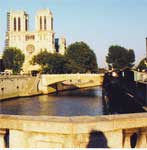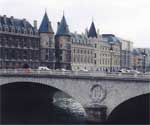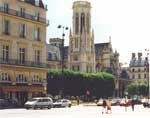 |
Medieval Paris
Romantic by definition, Paris can easily steal your attention and
change your plans on the fly. To avoid that, make sure you have
carefully planned for each day you will spend in the "City of Light". After reaching all the objectives planned for that day, then you can switch to "browsing mode"
by late afternoon. Until then, your hard "Medieval Day" might not
be that hard after all! Walking, that's the keyword, walking from one monument to another, you can stop and relax over coffee or a glass of red wine at a sidewalk café,
while letting things settle in your mind.
The  is the
sign of "Le Métro" (the Parisian Subway), as you will find it on most maps.
Next to it is the name of the Station. Whenever possible, do not
take the Subway, but try to walk, and walk, and walk! This is the
most rewarding experience in Paris! is the
sign of "Le Métro" (the Parisian Subway), as you will find it on most maps.
Next to it is the name of the Station. Whenever possible, do not
take the Subway, but try to walk, and walk, and walk! This is the
most rewarding experience in Paris!
I know, it depends on where your hotel is. Paris is divided in "Arrondissements"
(Districts), and for me, "Le Marais" (3e Arrondissement) works
the best. It is an ancient neighborhood on the Right Bank of river
Seine, offering by itself a lot to see. With a bit of an effort,
everything on this page, plus Louvre, Tuilleries, Place de La Concorde,
Champs Elysées, can be reached by walking. Actually you can walk all the
way to the L'Arc de Triomphe! I did it, as an afternoon walk (in the
"browsing" mode).
Now, let's go back to our "Do not miss!" Tour: Notre-Dame Cathedral
 Place du Parvis de Notre Dame, 75004 Paris Place du Parvis de Notre Dame, 75004 Paris
 Cité Cité
 The Gospel was first preached in Paris by
Saint Denis in the First Century, or, as some suppose, by another saint
by the same name in the Third Century. As early as A.D. 365, a
chapel dedicated to Saint Stephen, the proto-martyr, was erected on the
bank of the Seine near the Eastern End of Île de la Cité, replacing a temple dedicated to Jupiter. This was enlarged into a beautiful basilica by Childebert I, in the year 522. In later years it was further extended so
as to cover a chapel of the Blessed Virgin which stood near it. The
entire structure was placed under the patronage of Our Lady. In 875 it
was destroyed by the Vikings, and afterwards reconstructed. In 1163,
under the episcopate of Maurice de Sully, the corner stone of the
present cathedral was laid near it by the illustrious Pope Alexander
III, then a refugee in France. In 1182, the Choir was dedicated by the
Papal Legate, and the nave began, and in 1185 Heraclius, Patriarch of Jerusalem, preached the Third Crusade from its tribune.
In 1208, the grand western façade was began, and in 1218, the last remains of the old church were destroyed to make room for the transept. The Gospel was first preached in Paris by
Saint Denis in the First Century, or, as some suppose, by another saint
by the same name in the Third Century. As early as A.D. 365, a
chapel dedicated to Saint Stephen, the proto-martyr, was erected on the
bank of the Seine near the Eastern End of Île de la Cité, replacing a temple dedicated to Jupiter. This was enlarged into a beautiful basilica by Childebert I, in the year 522. In later years it was further extended so
as to cover a chapel of the Blessed Virgin which stood near it. The
entire structure was placed under the patronage of Our Lady. In 875 it
was destroyed by the Vikings, and afterwards reconstructed. In 1163,
under the episcopate of Maurice de Sully, the corner stone of the
present cathedral was laid near it by the illustrious Pope Alexander
III, then a refugee in France. In 1182, the Choir was dedicated by the
Papal Legate, and the nave began, and in 1185 Heraclius, Patriarch of Jerusalem, preached the Third Crusade from its tribune.
In 1208, the grand western façade was began, and in 1218, the last remains of the old church were destroyed to make room for the transept.
This superb Cathedral has three portals:
the central one called that of the Last Judgment, the northern one that of the Virgin, and the southern one that of St. Anne.
Across the whole façade, above the portals, runs a gallery upon which are twenty-eight statues representing the Kings of France, from Childebert I to Phillip II.
La Sainte Chapelle
 4, Boulevard du Palais, 75001 Paris 4, Boulevard du Palais, 75001 Paris
 Cité Cité
 Situated within walking distance from Notre-Dame, La Saint Chapelle is a
magnificent display of Gothic Architecture. It was built under Louis IX. The King decided to build a chapel worthy to be the abiding place
of two precious relics he obtained from the Emperor of Constantinople: the Crown of Thorns and part of the Holy Cross. The architect Pierre de Montreuil
was entrusted with the commission. The construction began in 1242, finished in 1247, and consecrated in 1248.
Watch for the amazing stained glass work. If you are there in a sunny day, sit on a bench facing the southern wall and look at how the stained glass windows colors are changing. Situated within walking distance from Notre-Dame, La Saint Chapelle is a
magnificent display of Gothic Architecture. It was built under Louis IX. The King decided to build a chapel worthy to be the abiding place
of two precious relics he obtained from the Emperor of Constantinople: the Crown of Thorns and part of the Holy Cross. The architect Pierre de Montreuil
was entrusted with the commission. The construction began in 1242, finished in 1247, and consecrated in 1248.
Watch for the amazing stained glass work. If you are there in a sunny day, sit on a bench facing the southern wall and look at how the stained glass windows colors are changing.
La Saint Chapelle contains two chapels: "La Chapelle Basse" (Lower Chapel) for the servants of the King, and "La Chapelle Haute" (The Higher Chapel) for the Royal Family.
Beside the beauty of the gothic interior itself, the two chapels are rich in symbols. The Lower Chapel has a blue ceiling decorated with the "Fleurs de Lys", the Royal Arms of France, suggesting the power of the
King over his subjects.
The Higher Chapel has a blue ceiling decorated with stars, as, among mortals, the King is the closest to God.
La Sainte Chapelle is now part of the "Palais de la Justice" complex.
La Conciergerie
 1, Quai de l'Horloge, 75001 Paris 1, Quai de l'Horloge, 75001 Paris
 Cité Cité
 La
Conciergerie is part of the same "Palais de la Justice" complex.
A fortress like building situated on the Ile-de-la-Cité, it is exhibiting the typical cylindrical French Medieval Towers.
Built at the beginning of the 14th Century under Philip IV (the Fair), was originally part of the Royal
Palace. After the Royals moved to Louvre, it was converted to a prison at the end of the 14th Century.
The most notable features are the ground floor Halls built under Philip IV: The Guards Room
(Salle des Gardes), and The Hall of Men-At-Arms (Salle des
Gens d'Armes), both being perfect examples of Civil Gothic Architecture. La
Conciergerie is part of the same "Palais de la Justice" complex.
A fortress like building situated on the Ile-de-la-Cité, it is exhibiting the typical cylindrical French Medieval Towers.
Built at the beginning of the 14th Century under Philip IV (the Fair), was originally part of the Royal
Palace. After the Royals moved to Louvre, it was converted to a prison at the end of the 14th Century.
The most notable features are the ground floor Halls built under Philip IV: The Guards Room
(Salle des Gardes), and The Hall of Men-At-Arms (Salle des
Gens d'Armes), both being perfect examples of Civil Gothic Architecture.
Saint-Germain-Des-Prés
 3, Place Saint-Germain-Des-Prés, 75006
Paris 3, Place Saint-Germain-Des-Prés, 75006
Paris
 Saint-Germain-Des-Prés Saint-Germain-Des-Prés
This is the oldest church in Paris. Founded by Childebert I, it
was dedicated to the Holy Cross and Saint Vincent. It was also
designated as the final resting place for the Merovingian Kings.
Destroyed by the Vikings, it was rebuilt under the Abbot Morard, between
990 and 1021. During the Middle Ages it was the most important
French Abbey, its influence as an intellectual centre spreading well
beyond Paris and France, to European dimensions.
Saint Germain L'Auxerrois
 2, Place du Louvre, 75001 Paris 2, Place du Louvre, 75001 Paris
 Louvre-Rivoli Louvre-Rivoli
 Facing the Louvre, Saint Germain L'Auxerrois is a wonderful church
in the Flamboyant Gothic Style of the 15th Century, when it was rebuilt.
The Choir, the western Portal, and the Chapel of Virgin were built in
the 13th Century. In the 14th Century the Royals moved to Louvre,
and Saint Germain L'Auxerrois became a Royal Church. It is from
its bell tower that the signal was given for the massacre of the
Huguenots in the Saint Bartholomew's Day, August 24, 1572. Facing the Louvre, Saint Germain L'Auxerrois is a wonderful church
in the Flamboyant Gothic Style of the 15th Century, when it was rebuilt.
The Choir, the western Portal, and the Chapel of Virgin were built in
the 13th Century. In the 14th Century the Royals moved to Louvre,
and Saint Germain L'Auxerrois became a Royal Church. It is from
its bell tower that the signal was given for the massacre of the
Huguenots in the Saint Bartholomew's Day, August 24, 1572.
Musée De Cluny
 6, Place Paul Painlevé, 75005 Paris 6, Place Paul Painlevé, 75005 Paris
 Cluny la Sorbonne Cluny la Sorbonne
If you are a die-hard medievalist, then
Musée De Cluny (Musée National du Moyen Age) is a must see. Built on the site of the Gallo-Roman Baths (1st-3rd Century), it is one of the few original remnants of the Medieval Paris.
The present building, L'Hôtel de Cluny, is a marvelous
combination of Flamboyant Gothic and Renaissance Architecture. And the
Museum Collections are simply amazing. First, there is a stunning
Collection dedicated to the daily life in the Middle Ages. Household
objects, tableware, costumes, you can see them the way they really were.
Then, there is the Collection of Tapestries, which includes the famous
"The Lady And The Unicorn" ("La Dame a la licorne"),
which dates from the 15th Century. You will just stay and look for
ages! The beautiful tapestry had to suffer because of flooding. It
was restored in modern times, using modern techniques, still the colors do not match the beauty
of the original ones! There are also Collections of Gothic
Sculpture, and Stained Glass. Here you can see original stained
glass windows from La Sainte Chapelle, removed from their place during
the French Revolution, and later recovered.
The Museum has also a section dedicated to Medieval Weapons, Medieval Armor and
other objects related to Chivalry.
Enjoy your vacation!
|
 |